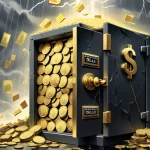Can Your Crypto Be Frozen? Uncovering the Risks of Tainted Funds in 2024

Can Your Crypto Be Frozen? The Hidden Risks of Tainted Funds
Waking up to a locked cryptocurrency wallet, your hard-earned Bitcoin or stablecoins untouchable—not because you broke any rules, but because someone upstream in the transaction chain did—is a nightmare becoming all too real. As the crypto space matures, the long arm of regulation and compliance can snag even the most innocent users, a point hammered home by Andrii Bruiaka, CEO of onicore.io and nonbank.io, in a sobering opinion on crypto risks.
- Illicit Crypto Threat: Over $40.9 billion tied to illegal activity in 2024, per Chainalysis, risking freezes for unaware holders.
- Regulatory Crackdowns: Tether froze $2.5 billion in shady funds; exchanges like MEXC banned 1,500 accounts.
- Proactive Defense: Tools like Nonbank.io screen wallets to dodge tainted funds and regulatory traps.
The Dark Underbelly of Crypto: Illicit Funds on the Rise
The crypto world has shed much of its early reputation as a lawless frontier, a tag often thrown around by folks like U.S. SEC Chair Gary Gensler. Bitcoin (BTC) and its peers once thrived in the shadows, hailed for privacy and freedom but equally infamous for fueling ransomware payments and darknet deals. Now, in 2024, with mainstream adoption picking up steam, regulators and law enforcement globally are watching like hawks. Compliance isn’t just a checkbox—it’s a lifeline. But here’s the gut punch: even if you play by the rules, a single tainted transaction can lock your funds tighter than a bank vault.
Let’s lay out the hard numbers, because they paint a bloody picture. Chainalysis, a top blockchain analytics outfit, pegs illicit crypto transactions at a jaw-dropping $40.9 billion for 2024, as detailed in their 2024 crypto crime report. That’s a lowball figure—past trends suggest it could creep past $51 billion as more dirty addresses get flagged. Over 60% of this filth ties to sanctioned entities, terrorist groups like Hamas, or state-backed hackers from North Korea, alongside sketchy exchanges like Russia’s Garantex. North Korean cybercriminals alone have swiped $2.2 billion in hacks this year, according to TRM Labs. Down under, Australian authorities just dismantled a $123 million crypto laundering racket. These aren’t abstract stats—they’re a glaring warning for anyone holding BTC, USDT, or any digital asset. One wrong move, even unknowingly, and you’re collateral damage.
Stablecoins and Exchanges: Heroes or Double-Edged Swords?
Stablecoins, often pitched as the safe harbor in crypto’s stormy seas, aren’t your get-out-of-jail-free card. Tether (USDT), the heavyweight in this arena, has frozen over $2.5 billion in funds linked to crime, with details emerging in reports like those from The Economist on Tether’s role in illicit finance. Recent moves include blocking $12.3 million on the Tron network and another $27 million tied to Garantex. Tether’s CEO, Paolo Ardoino, lays out their mission with no ambiguity:
“Tether’s ability to track transactions and freeze USDt linked to illicit activity sets it apart from traditional fiat and decentralized assets. We take our responsibility to combat financial crime seriously and will continue working closely with global law enforcement agencies to prevent bad actors from exploiting stablecoin technology.”
That’s a bold claim, and their work with law enforcement isn’t fluff—nearly $80 million in USDT has been traced to exchanges linked to Hamas since early 2024. But let’s not drink the Kool-Aid just yet. Dig deeper, and you’ll find sharp critiques arguing Tether’s stability and relative anonymity make it a damn magnet for money launderers. Billions might still slip through the cracks, feeding a shadow economy, as explored in discussions on the impact of Tether freezes on crypto crime. So, is Tether cleaning up the streets or just playing a flashy game of whack-a-mole while its design fuels the very crime it fights? It’s a messy duality that deserves a hard look.
Centralized exchanges aren’t sitting on their hands either. MEXC, a major trading platform, recently axed over 1,500 accounts for market manipulation, proving that even user behavior can trigger a hammer drop. And it’s not just the big players. Blockchain surveillance tools from firms like Chainalysis, TRM Labs, and Elliptic—think of them as digital bloodhounds—can sniff out funds across networks, tagging “risky” wallets linked to ransomware, fraud, or sanctioned groups. Governments are getting crafty too; Hong Kong’s using tokenized legal notices on blockchain to hunt anonymous owners of illicit wallets. The takeaway? There’s no hiding. Even if you’re pure as snow, accepting a payment for a gig or a P2P trade from a tainted address can blacklist your funds. Guilt by association isn’t just a phrase—it’s a financial guillotine.
Self-Sovereignty Under Siege: Adapt or Get Burned
Self-sovereignty—controlling your money without middlemen—is the beating heart of crypto’s ethos. But as Andrii Bruiaka puts it, with zero sugarcoating:
“Sovereignty without foresight is a liability. The solution is not to retreat into maximalist purism or ignore compliance realities, but to adapt on our own terms.”
He’s hitting the nail on the head. The era of shrugging off Anti-Money Laundering (AML) and Know Your Customer (KYC) rules—processes to stop financial systems from being used for crime—is dead and buried. Once a headache just for centralized exchanges, compliance now creeps into every nook of the ecosystem. There’s a silver lining: illicit transaction volume as a slice of total crypto activity shrank from 0.61% in 2023 to 0.14% in 2024, per Chainalysis, with TRM Labs noting a 51% drop in raw illicit value. That’s not dumb luck; it’s tighter rules, sharper tools, and the industry stepping up. But don’t get cozy—crypto crime is getting slicker. From on-chain laundering hubs like Huione to national security threats, crooks are evolving fast. For everyday users, receiving “dirty” crypto by accident is like holding a live grenade, a concern echoed in community discussions on wallet freezes and illicit transactions.
Picture this: you’re a freelancer paid in Bitcoin for a design job. You accept the funds, no questions asked, only to find your wallet flagged by Chainalysis because the client’s BTC came from a hacked exchange. Next thing you know, your exchange account is frozen, your funds are untouchable, and you’re stuck explaining yourself to regulators—or worse, you can’t. That’s the real-world sting of tainted funds, and it’s not science fiction; it’s happening now.
Fighting Back: Tools to Protect Your Crypto Assets
So, how do you dodge this bullet? Start with proactive wallet screening. Tools from Chainalysis, TRM Labs, and Elliptic let you check the risk of incoming funds before hitting “accept.” Think of it as running a background check on money—see if it’s tied to ransomware, darknet markets, or sanctioned entities. For the average user, spotting red flags means watching for odd transaction patterns, like huge sums from new wallets with no history, or funds bouncing through multiple addresses fast, a tactic often linked to cryptocurrency tumbling for laundering. Free versions of these tools exist, like Chainalysis’ basic risk reports, while paid tiers dig deeper into transaction chains.
Nonbank.io, Bruiaka’s brainchild, kicks it up a notch. Their platform bakes AML screening right into wallets, using proxy wallets as a buffer zone. Here’s how it works: incoming funds hit a temporary holding spot where they’re scanned for suspicious histories or origin addresses. If something smells fishy, it’s flagged before ever touching your main stash or exchange-linked accounts. It’s like a firewall for your crypto—keeping the bad stuff out without handing over custody, as explained in depth on Nonbank.io’s approach to AML compliance. Nonbank’s roadmap doesn’t stop at defense; they’re eyeing multi-blockchain wallets by Q3 2024 and full bank-crypto integration by Q2 2025. If they nail it, they’re not just a shield—they’re a gateway to dragging crypto into the mainstream. But let’s not get starry-eyed. Could tools like this morph into overreach, becoming surveillance traps themselves? It’s a fair worry when every transaction gets a magnifying glass.
If the worst happens and your funds get frozen, don’t just panic—act. Document every transaction detail, reach out to the exchange or wallet provider with proof of your innocence, and consider legal help if the sum is big. It’s a slog, and there’s no guarantee, but sitting idle isn’t an option. Prevention beats cure every damn time, and there are resources like tips for safeguarding crypto assets that can guide you through the process.
The Bitcoin Maximalist Dilemma: Freedom vs. Reality
Bitcoin maximalists—those who see BTC as the only true crypto, born from Satoshi Nakamoto’s vision of unstoppable, decentralized money—might scoff at compliance as a betrayal. And they’ve got a point: Bitcoin’s blockchain, with its transparent ledger of unspent transaction outputs (UTXOs), was built for trustless freedom, not regulatory chokeholds. Compare that to privacy coins like Monero, which obscure transaction details, or Ethereum, where smart contracts can muddy tracing efforts with complex code. Bitcoin’s simplicity makes it both a surveillance dream for regulators and a purity test for purists. But here’s the cold truth: pretending rules don’t exist won’t save your stack. Ignore gravity, and you still crash. Some maximalists argue every AML step erodes crypto’s soul, turning it into just another bank toy. Fair enough, but when $40.9 billion in dirty funds casts a shadow over every holder, adaptation isn’t surrender—it’s survival.
Let’s not pretend the data tells the whole story either. Chainalysis admits their $40.9 billion figure skips non-crypto-native crimes like drug deals unless law enforcement confirms them, and they dodge unproven links to extremism or market scams. The real scale of tainted crypto might be uglier than we think. Criminals aren’t amateurs anymore; they’re building sprawling networks and custom laundering platforms. Regular users are outgunned, and no amount of “HODL” dogma changes that.
Compliance as a Catalyst: Growing Pains or Power Boost?
Here’s the flip side: this regulatory storm isn’t pure doom. It’s crypto growing up. Institutional cash is flooding in because AML practices are tightening, and blockchain’s transparency makes hiding shady moves tougher by the day. For every North Korean hack or Hamas wallet, there’s a Tether freeze or a Nonbank innovation pushing back. The revolutionary spark—disrupting centralized finance, championing privacy, driving freedom—doesn’t have to fizzle under red tape. It needs to evolve. Effective accelerationism (e/acc) isn’t about blind hype; it’s about building faster and smarter. Nonbank.io’s hustle to merge compliance with usability is e/acc in action—speeding adoption not through chaos, but through grit and brains. Done right, compliance isn’t a brake; it’s a goddamn turbocharger.
Still, the tension gnaws: how do we guard self-sovereignty without losing crypto’s edge? It’s a riddle worth millions in BTC. Altcoins and other chains like Ethereum fill niches Bitcoin doesn’t touch—smart contracts, DeFi, tokenization—that fuel this financial uprising. Bitcoin may be king, but the ecosystem thrives on diversity. Ignoring that for purist dogma is as shortsighted as dodging compliance. The regulators are watching, crooks are innovating, and your funds are only as safe as your next play.
What’s Next for Crypto Compliance?
Looking ahead, the compliance squeeze will likely tighten. Global regulators are syncing up, and expect harsher AML frameworks as crypto weaves deeper into traditional finance. At the same time, decentralized pushback—think privacy protocols or off-grid wallets—could spark a counterwave. The line between freedom and oversight is razor-thin. Will tools like Nonbank.io redefine sovereignty on user terms, or will overreach turn crypto into Big Brother’s sandbox? One thing’s sure: the game’s just heating up, and sitting on the sidelines isn’t an option.
Key Takeaways and Burning Questions
- How can I protect my crypto from being frozen over illicit ties?
Screen incoming funds with tools like Chainalysis or TRM Labs to spot risky transactions upfront. Platforms like Nonbank.io offer proxy wallets to isolate tainted funds before they hit your main accounts or exchanges. - What’s the real danger of receiving dirty crypto, even by mistake?
Accidentally taking funds linked to crime—think ransomware or sanctioned groups—can freeze your wallet, blacklist your address, or land you in legal hot water. With $40.9 billion in illicit transactions out there, the risk is no joke. - Why is AML compliance a must for crypto’s future?
AML builds trust for mass adoption, lures big institutional money, and shakes off crypto’s shady rep. Plus, blockchain surveillance makes hiding dirty deals harder every day. - How does Nonbank.io tackle compliance without killing sovereignty?
Nonbank.io embeds AML checks into wallets, using proxy buffers to scan funds for red flags before they mix with your stash. It’s about staying clean while keeping control. - Is Tether a fix or a flaw in fighting crypto crime?
Tether’s frozen $2.5 billion in illicit funds shows muscle, but its anonymity and stability also draw money launderers. It’s a double-edged sword—part cop, part enabler.



